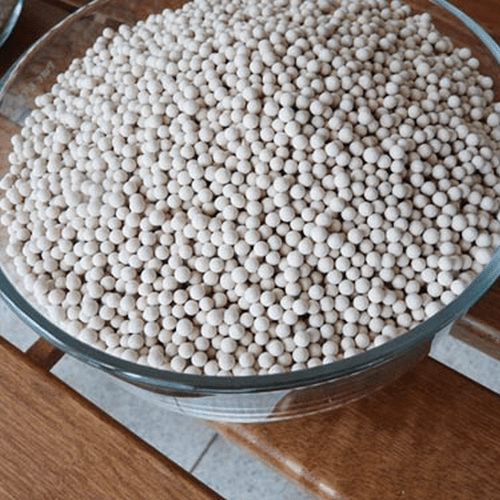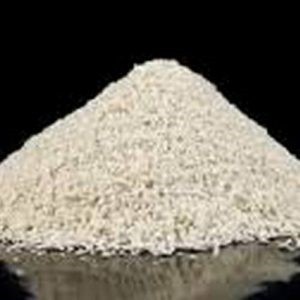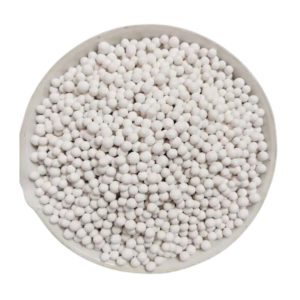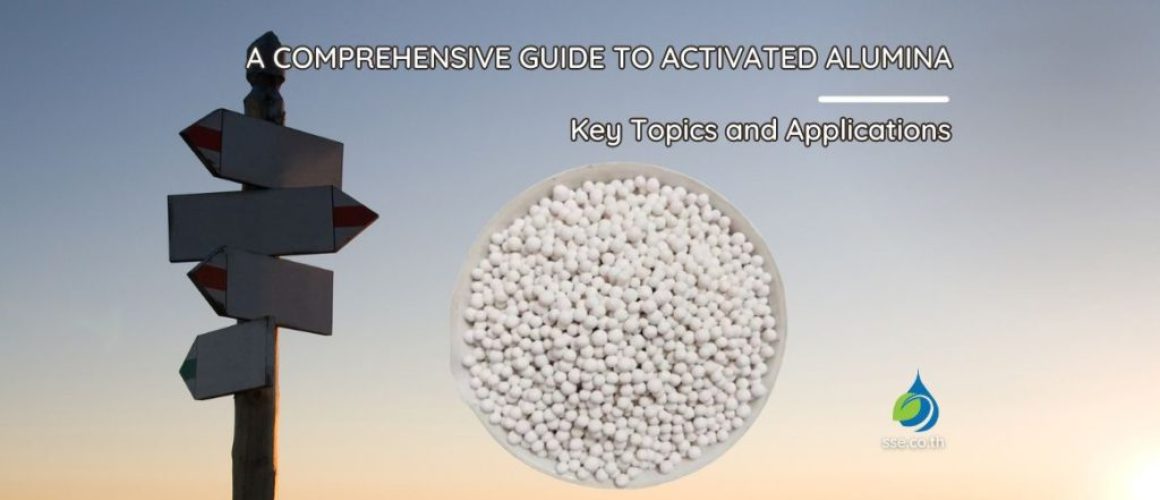A Comprehensive Guide to Activated Alumina 2024
| Topic | Description |
|---|---|
| What is Activated Alumina? | A porous, highly adsorbent form of aluminum oxide used in various applications such as water treatment, air drying, and as a catalyst in the chemical industry. |
| How does it work? | It works by adsorbing contaminants onto its surface due to its high surface area and porous structure. |
| Main Uses | Used in water treatment for fluoride and arsenic removal, air drying for compressed air and gas purification, and as a catalyst in the chemical industry. |
| Regeneration | Activated alumina can be regenerated by heating it to a high temperature, typically between 200-350°C, to remove the adsorbed contaminants. |
| Safety | It is generally safe to use when handled and disposed of properly. |
| Lifespan | The lifespan of activated alumina depends on its application and operating conditions. In some cases, it can last for several years before it needs to be replaced or regenerated. |
| Advantages and Disadvantages | It offers several advantages, such as its high adsorption capacity, ability to remove a wide range of contaminants, and its regenerability. However, it also has some disadvantages, including the potential for dust formation and the need for careful handling and disposal. |
| Specifications | The specifications of activated alumina can vary depending on the application and manufacturer. Key specifications often include particle size, pore size, surface area, bulk density, and adsorption capacity. |
“Activated Alumina’s efficiency is in the details—from selecting the right bead size to mastering storage, each factor plays a critical role in maximizing performance.”
Table of Contents
Introduction
Activated Alumina is a powerful adsorbent used across industries for gas purification, water treatment, and moisture control. This guide explores the versatility of Activated Alumina, its critical applications, and best practices for storage and handling. Below are links to related articles, each focusing on specific uses, properties, and handling techniques for Activated Alumina, tailored to various industries.
Advantages of Using Activated Alumina
- High adsorption capacity for water and gas impurities.
- Durable and resistant to high temperatures.
- Can be regenerated and reused in many applications.
- Effective in a wide range of industrial settings.
- Cost-effective compared to other specialized adsorbents.

Understanding Activated Alumina’s Properties and Mechanisms
Activated Alumina is highly porous, offering an impressive surface area that captures impurities and moisture effectively. For foundational knowledge, start with An Introduction to Activated Alumina and Understanding Activated Alumina Adsorption. These cover its unique adsorptive properties, pore structure, and heat tolerance.
Key Properties of Activated Alumina for Industrial Applications
| Property | Description |
|---|---|
| Surface Area | High surface area allows for effective adsorption. |
| Bulk Density | Critical for storage and handling in large quantities. |
| Thermal Stability | Resists high temperatures, ideal for gas purification. |
| Pore Volume | Enables high moisture adsorption capacity. |
| Crush Strength | Suitable for rugged industrial environments. |
Industrial Applications of Activated Alumina
- Gas Purification
Essential for cleaning industrial gases, Activated Alumina helps purify hydrogen, nitrogen, and natural gas. Learn more in Activated Alumina Gas Purification. - Moisture Control and Sulfur Removal
Activated Alumina adsorbs moisture in air and gas systems, protecting equipment. Read about Activated Alumina for Sulfur Removal and Moisture Removal Applications to see how it mitigates corrosion and contamination. - Water Treatment
Its role in water treatment is significant, particularly for fluoride and arsenic removal, ensuring safe drinking water. For more on water purification, check Activated Alumina in Water Treatment. - Food & Beverage Applications
Activated Alumina ensures moisture control in food production and packaging, maintaining product quality. Explore details in Activated Alumina in the Food and Beverage Industry. - Pharmaceutical Uses
It is widely used in drug production for moisture and contaminant control, enhancing product stability. Learn more in Activated Alumina in the Pharmaceutical Industry.
Typical Applications by Industry
- Water Treatment: Fluoride and arsenic removal.
- Oil and Gas: Sulfur and moisture removal.
- Compressed Air Systems: Drying compressed air lines.
- Food & Beverage: Preservation and moisture control.
- Pharmaceutical: Moisture-sensitive drug storage.
Common Industrial Uses of Activated Alumina
| Industry | Application |
|---|---|
| Water Treatment | Fluoride and arsenic removal from drinking water. |
| Oil and Gas | Sulfur removal in refining and gas purification. |
| Pharmaceutical | Moisture control during drug production. |
| Food & Beverage | Drying and preservation in packaging processes. |
| Compressed Air Systems | Moisture adsorption in air lines and equipment. |
Specialized Industrial Applications
- Air Drying in Compressed Systems
Activated Alumina is ideal for air drying in compressed air systems, preventing issues related to moisture. See Compressed Air Systems with Activated Alumina for full benefits. - Ethylene and Propylene Production
In petrochemical production, it plays a crucial role in creating ethylene and propylene. Discover how in Activated Alumina in Ethylene and Propylene Production. - Sulfonation Process Air Drying
For ultra-low dew points needed in sulfonation, Activated Alumina and silica gel are used together. Check Achieving the Perfect Dry in Sulfonation for details. - Paint Production
Activated Alumina stabilizes moisture-sensitive compounds in paints. See its benefits in Activated Alumina in Paint Production.
Selecting the Right Type and Size of Activated Alumina
Choosing the correct bead size ensures Activated Alumina’s effectiveness in specific applications. For guidance, refer to Activated Alumina Bead Sizes. Additionally, learn about powder forms and potential applications in The Potential of Activated Alumina Powder.
Optimizing Performance and Longevity
To achieve maximum efficiency and longevity, controlling storage conditions is vital. Read Factors Affecting the Performance and Lifetime of Activated Alumina for factors that can influence its performance.
- Storage and Handling
Proper packaging and handling can prevent degradation. Explore Packaging and Storage of Activated Alumina for best practices. - Safety Guidelines
Safe handling of Activated Alumina protects users from health risks. Review recommended procedures in Safety and Handling Guidelines for Activated Alumina. - Regeneration Techniques
Regenerating Activated Alumina enhances sustainability and reduces costs. For effective regeneration methods, refer to The Regeneration Process of Activated Alumina.
Packaging Options for Activated Alumina
| Packaging Type | Capacity | Purpose |
|---|---|---|
| Air-Tight Iron Drums | 30 kg | Prevents moisture ingress, ideal for long-term storage. |
| Woven Bags | Custom | Flexible for different storage needs; requires additional moisture control. |
| Custom Packaging | Variable | Tailored solutions for unique industrial requirements. |
Key Factors Affecting Performance and Longevity
- Exposure to air and humidity outside of controlled environments.
- Handling without resealing promptly.
- Storage in high-temperature or variable climates.
- Physical contamination or contact with chemicals.
- Incorrect bead or particle size for specific applications.
Comparisons with Other Desiccants
Activated Alumina is often compared with silica gel, molecular sieves, and activated carbon. Learn the advantages of each in Comparing Activated Alumina with Other Desiccants. For applications in gas purification, explore CO₂ and N₂ Adsorption.
Adsorption Comparison – Activated Alumina vs. Other Desiccants
| Desiccant | Adsorption Capacity | Ideal Applications | Cost |
|---|---|---|---|
| Activated Alumina | High | Water treatment, gas purification | Moderate |
| Silica Gel | Moderate | Pharmaceuticals, electronics | Low |
| Molecular Sieves | Very High | Precision drying, gas separation | High |
| Activated Carbon | Variable | Odor removal, organic vapor capture | Moderate |
Activated Alumina in Pressure Swing Adsorption (PSA)
Pressure Swing Adsorption (PSA) separates gases, powered by Activated Alumina’s adsorptive capabilities. For PSA fundamentals, check Pressure Swing Adsorption.
Choosing the Right Desiccant for Compressed Air Systems
For compressed air applications, selecting an appropriate desiccant is essential. Compare Activated Alumina with other options in Choosing the Right Desiccant for Compressed Air Systems.
Frequently Asked Questions
What is activated alumina?
Activated Alumina is a porous, adsorbent form of aluminum oxide, commonly used in water treatment, air drying, and catalysis.
How does activated alumina work?
It works by adsorbing contaminants onto its surface due to its high surface area and pore structure, effectively capturing impurities in gases and liquids.
What are the primary uses of Activated Alumina?
Primary applications include water treatment (fluoride and arsenic removal), air and gas drying, and serving as a catalyst in the chemical industry.
What are the key advantages of Activated Alumina?
High adsorption capacity, regenerability, selectivity for contaminants, durability, and cost-effectiveness make it a versatile choice for various applications.
How can Activated Alumina be regenerated?
It can be regenerated by heating (200-350°C) to remove adsorbed contaminants, allowing reuse in adsorption cycles.
Is Activated Alumina safe to use?
Yes, with proper handling. It’s non-toxic but should be managed with appropriate PPE (gloves, masks) to minimize dust exposure.
How long does Activated Alumina last in use?
Depending on conditions and application, it can last several years, especially if periodically regenerated to restore adsorption capacity.
What are the disadvantages of using Activated Alumina?
Potential dust formation, the need for safe handling, and environmental exposure risks are primary disadvantages to be managed.
What are the specifications to consider?
Specifications include particle size, surface area, pore size, bulk density, and adsorption capacity, tailored to each application.
What is the difference between Activated Alumina and standard alumina?
Standard alumina is non-porous, while Activated Alumina is highly porous and adsorbent, suitable for applications needing moisture or impurity control.
How is Activated Alumina prepared?
It’s made by precipitating aluminum hydroxide, drying, and calcining at high temperatures to create a porous structure with a high surface area.
What’s the CAS number for Activated Alumina?
Activated Alumina shares the CAS number 1344-28-1 with aluminum oxide, though it’s specifically modified for adsorptive uses.
How do you store Activated Alumina?
Store in a cool, dry environment in airtight containers to prevent premature adsorption of moisture from the air.
Can Activated Alumina adsorb all types of contaminants?
It has high affinity for water, fluoride, arsenic, sulfur compounds, and organic vapors but is less effective with certain other gases.
What are the main differences between Activated Alumina and silica gel?
Activated Alumina has higher thermal stability, making it more suitable for high-temperature applications, while silica gel is better for delicate environments.
How is Activated Alumina used in compressed air systems?
It adsorbs moisture in compressed air lines, reducing corrosion risks and maintaining equipment efficiency.
How does Activated Alumina perform in water treatment?
It selectively removes contaminants like fluoride and arsenic, commonly in drinking water and wastewater treatment systems.
What are common bead sizes, and why do they matter?
Common bead sizes for Activated Alumina include 1-2mm, 2-4mm, 3-5mm, and 5-8mm. Bead size selection impacts performance in applications due to differences in surface area and flow dynamics. Smaller beads offer a higher surface area, maximizing adsorption rates and efficiency but may reduce flow rates and increase pressure drops. Larger beads, with lower surface area but increased flow capacity, suit high-flow applications like gas drying where lower pressure drops are prioritized. Choosing the right bead size balances adsorption capacity with system flow requirements.
What precautions are necessary when disposing of Activated Alumina?
Disposal should follow environmental regulations, especially if it has adsorbed hazardous substances, to prevent contamination.
Can Activated Alumina be used with other desiccants?
Yes, it’s often used alongside silica gel and molecular sieves to optimize moisture control across a range of environmental conditions.
“With the right practices, Activated Alumina can last years, adsorbing moisture and contaminants while keeping industrial systems efficient and protected.”
Conclusion and Further Reading
Activated Alumina’s versatility makes it essential across many industries, from gas purification to moisture control. For those looking to explore the diverse industrial applications of this powerful adsorbent, Activated Alumina Applications: Industrial Uses in Drying, Purification, and Catalysis provides an in-depth look at how activated alumina supports processes like moisture control, gas purification, and catalytic reactions across various industries. This guide outlines its indispensable role in sectors from environmental management to petrochemical refining, highlighting its versatility and efficiency in enhancing industrial performance.
Activated Alumina’s performance and longevity rely on correct selection, handling, and storage practices tailored to specific applications. Whether you’re using it for water treatment, air drying, or gas purification, choosing the right bead size and following best practices ensures optimal efficiency. Ready to experience the benefits of Activated Alumina for your business? Visit our product page to explore high-quality options: Activated Alumina Products.
 แอคติเวต อะลูมิเนียมที่เปิดใช้งาน Activated Alumina Powder (25kg/drum)
แอคติเวต อะลูมิเนียมที่เปิดใช้งาน Activated Alumina Powder (25kg/drum) แอคติเวต อะลูมิเนียมที่เปิดใช้งาน Adsorbent Activated Alumina Size 4-8mm (30kg/drum)
แอคติเวต อะลูมิเนียมที่เปิดใช้งาน Adsorbent Activated Alumina Size 4-8mm (30kg/drum) แอคติเวต อะลูมิเนียมที่เปิดใช้งาน Adsorbent Activated Alumina (HYAA300) Size 3-5mm (30kg/drum)
แอคติเวต อะลูมิเนียมที่เปิดใช้งาน Adsorbent Activated Alumina (HYAA300) Size 3-5mm (30kg/drum) อะลูมินากัมมันต์ การบำบัดน้ำ Activated Alumina (HYAA300) Size 4-8mm (210kg)
อะลูมินากัมมันต์ การบำบัดน้ำ Activated Alumina (HYAA300) Size 4-8mm (210kg) อะลูมิเนียมที่เปิดใช้งาน HYAA300 ขนาด 3-5 มม. (210 กก.) สำหรับการบำบัดน้ำ
อะลูมิเนียมที่เปิดใช้งาน HYAA300 ขนาด 3-5 มม. (210 กก.) สำหรับการบำบัดน้ำ
